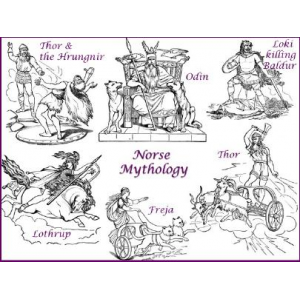 To say that the Gods and Goddesses are real is not to tell us much. The next question is...what are they like?
To say that the Gods and Goddesses are real is not to tell us much. The next question is...what are they like?
Aside from the odd personal encounter and rare representations as statues or on old tapestries, the only descriptions we have of the Holy Powers are in the myths. When we look at the stories, we find Thor pictured as a muscular fellow with a red beard and flashing blue eyes. Odin is a tall, older man with a gray beard and one eye, and he sometimes travels in the company of his two wolves and ravens. Freyr - well, he's a fertility God, with the appropriate physical attributes.
Are we to take these vivid, dramatic images literally? That depends on how you want to think of the Gods and the myths in which they appear. Here are two possibilities:
We can think of myth as metaphor. In this scheme, the myths are symbolic ways of transmitting spiritual truths. They have multiple layers of meaning. On the most obvious and superficial level, they are entertaining tales that often make a moral point or illustrate virtues like the love of wisdom, sacrifice, and bravery.
Below this level, things get trickier. Some mythologists (not themselves followers of our ancestral religion) will say they are allegories describing natural phenomena such as lightning, or the warming of the land with the departure of winter, or the cycle by which vegetation grows, dies in the winter, and comes to life again in the spring.
Psychologists, particularly those who are students of Dr. Carl Jung, interpret the myths as depictions of psychic realities rather than external ones. In this model, the ancient stories tell us important things about the personal and collective unconscious. The heroic quest and the growth and maturation of the individual are typical themes. The Gods and goddesses are thought of as psychic forces in the person and in society, but are not considered objectively real.
We can admit the value of these viewpoints in a technical or analytical sense, while not conceding they represent the whole truth. Many Asatruar consider the myths to be true - not in the literal sense but in the sense of tales which tell spiritual truths, "those things which never happened, but always are." The tales of Gods become allegories, some of which can be deciphered by reason. Others cannot be interpreted in terms of logic, because they speak a deeper, non-linear "meta-language," the secret code of the unconscious. In this case, the myths communicate with us subtly, without words, influencing our mind and spirit.
For Asatruar who think of the myths as metaphor, the Gods and Goddesses are real, but the anthropomorphic images of them presented in the old lore are strictly symbolic. Thor is not really a gigantic, muscular, man-like figure with a red beard, any more than Jehovah is a human-shaped entity in a white gown sitting on a golden throne, surrounded by clouds. The description of Thor we find in the stories gives us a way to relate to the very real force in the cosmos that we call Thor, but it is not him.
The Gods and Goddesses are not limited by the constraints of flesh and blood. So while it is convenient for us to picture Freya as a beautiful woman wearing a shining necklace, or Heimdal as having golden teeth, these are allegorical. The Gods and Goddesses themselves are mighty spiritual powers, existing within us and without us, capable of manifesting to humans in any form they wish.
Free eBooks (Can Be Downloaded):
Phil Hine - Devotions And DemonessesFranceska De Grandis - Goddess Initiation
Joseph John William - Voodoos And Obeahs Phases Of West India Witchcraft
Michael Jordan - Dictionary Of Gods And Goddesses